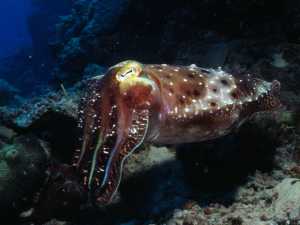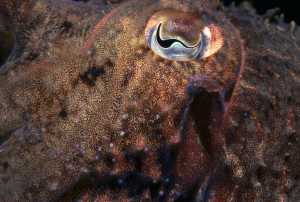What makes the Cuttlefish so good at controlling its colour and blending in with its surroundings? This month scientists at Harvard University and the Woods Hole Marine Biological Laboratory have helped answer that question.
It has been long known that the skin of the Cuttlefish contains chromatophores: yellow, red, and brown pigmented sacs that the Cuttlefish can expand and contract to allow their skin to act as a color filter of their surrounding light. In addition, Cuttlefish contain leucophores and iridophores that, respectively, scatter light over the entire visible spectrum and reflect light.
Under control of their nervous system, Cuttlefish can reportedly change the surface area of the pigmented sacs by as much as 500% (allowing for different combinations of pigments to be combined to a greater or lesser degree and providing different gradations in color filtration). However, that alone doesn’t explain the color repertoire of the Cuttlefish and the speed with which it can change colors.

What the scientists discovered and published for the first time is that the chromatophores also contain luminescent protein structures that allow them to actively emit light, not just reflect and filter the ambient light from their environment.
In addition, they also discovered the presence of reflectin in the chromatophores, a high-refractive-index protein that, they suggest, allows the chromatophores, when highly stretched out, to more effectively absorb light than if they contained color pigments alone. Another protein, crystallin, was also found there, adding to the understanding that chromatophores are not simply sacs of pigment as previously thought.
It is this combination of light emission and enhanced reflection/filtering abilities that provides the Cuttlefish with its impressive flexibility of appearance.
The researchers suggest that bioinspiration from the Cuttlefish could provide designs for new types of thin, flexible displays with superior colour contrast and accuracy. They also note that this enhanced colour contrast would provide better ability to disrupt pattern recognition as compared with pixilation camouflage technologies (such as are found in current military uniforms).
Further Reading
The original published article is entitled The structure–function relationships of a natural nanoscale photonic device in cuttlefish chromatophores and the publication can be found here: http://rsif.royalsocietypublishing.org/content/11/93/20130942
The abstract is free, but the article requires a subscription. This article from Harvard School of Engineering and Applied Sciences gives a high level summary of the article with some discussion of potentially interesting applications.
The Cuttlefish: a Source of Inspiration gives a more general overview of this fascinating creature.
Photo credits: Tim Nicholson, David Collins
















